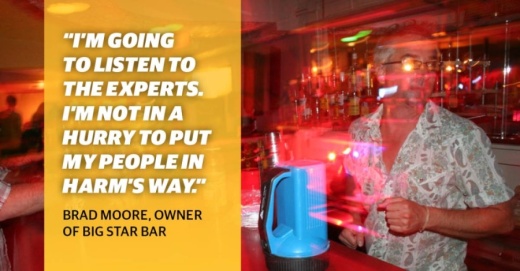“I’m not a science guy ... but I am a trust-in-science guy,” said Brad Moore, the owner of Big Star Bar in the Heights, Grand Prize in the Montrose area and others. “I’m going to listen to the experts. I’m not in a hurry to put my people in harm’s way.”
As of press time, Harris County Judge Lina Hidalgo insisted against reopening bars despite nearly every neighboring county doing so, citing the indicators on the county’s threat level system.
Even so, most bars have been able to reopen with food service permits. Bars and restaurants with liquor licenses in the Heights, River Oaks and Montrose area are slowly recovering, and as of August they are down 44% in sales compared to the same point last year, according to Texas beverage tax filings.
As positivity rates dipped but then began to tick upward in Harris County in October, health experts advised continued caution in the haste to reopen more gathering spaces.
“Even if the numbers go in the right direction—which would be wonderful news—and these places are able to reopen, that does not mean we’re going back to the way it was before,” said Dr. Jill Weatherhead, the assistant professor of infectious disease at the Baylor College of Medicine.
Keeping tabs
Abbott’s order allows bars to open with 50% capacity along with mandatory facial coverings when 6 feet of social distancing cannot be maintained.
“It’s time to open them up,” Abbott said in the Oct. 7 announcement. “If we continue to contain [COVID-19], then the openings, just like other businesses, should be able to expand in the near future.”
Bars previously opened for five weeks in May and June but shut down again June 26 when coronavirus cases and hospitalizations surged. In August, the Texas Alcoholic Beverage Commission allowed bars to reclassify as restaurants, allowing most to find a way to open their doors.
“It changes on us, so we take it week by week,” Moore said. “If you asked me two weeks ago, I might have said, ‘We’ll see; things might loosen up, and we might be able to open some of our patios in a couple weeks.’”
Under the state’s new guidelines, any county with under 15% of its hospital capacity used by COVID-19 patients can apply to the TABC to reopen bars. Harris County’s COVID-19 capacity had been averaging 4% for at least two weeks as of Oct. 25, according to data published by the Southeast Texas Regional Advisory Council. During the July surge, that figure was over 30%.
“The data guiding county decision-making tells us we are doing much better than we were a few months ago, but we are still at the highest level: red,” Hidalgo said in a statement. “Indoor, maskless gatherings should not be taking place right now, and this applies to bars, as well.”
Amid the closures, many bar owners took the opportunity to adapt. Rebar in Montrose took on a remodel, adding kitchen facilities and rolling out Sunday brunch service and other options. Barcode, also in Montrose, served as a neighborhood food pantry. Alba Huerta of Julep on Washington Avenue launched a to-go cocktail truck.
“It was not easy, but we saw the opportunity and went for it,” she said. “It’s a good thing, actually, and we’re very blessed to actually be able to do some work.”
Gathering places
Longtime bar owner Miggy Ramirez of Lola’s Depot in Montrose—with nearly 40 years in business—fears some bars that have opened are not being responsible, which could lead to further outbreaks.
“Some people who get into the bar business, they might not have the most integrity. They just care about their cash flow and not so much about people,” he said.
He said there is a compounded effect because the competition is limited, leading to more crowding. In late October, four Houston bars were suspended over health protocols, according to a TABC news release.
Capacity limits are crucial for indoor gatherings, but even then, the ideal situation is outdoors with social distancing, Weatherhead said.
“If you insist on going out, first weigh the risks and benefits to you and your household but also the greater community,” she said. “Then call the restaurant or bar and ask them what they are doing to protect their workers and guests and do they have enough outdoor seating.”
Meanwhile, owners who opt to remain closed suffer, Ramirez said.
“A lot of people, they’re bartenders for years, and their life savings goes to get a bar and keep it going. I’m afraid a lot of those may not make it, or worse, fewer will have that opportunity to even try,” he said.
As for his bar, he is planning to revive a food truck and try patio service in the coming weeks. He said he is doing it to help give his customers a place to go.
“This is a neighborhood bar; it’s like a family. ... It’s also the biggest little watering hole for the whole city,” Ramirez said. “But I don’t want anyone getting sick. I don’t care about how much money I’m losing.”





